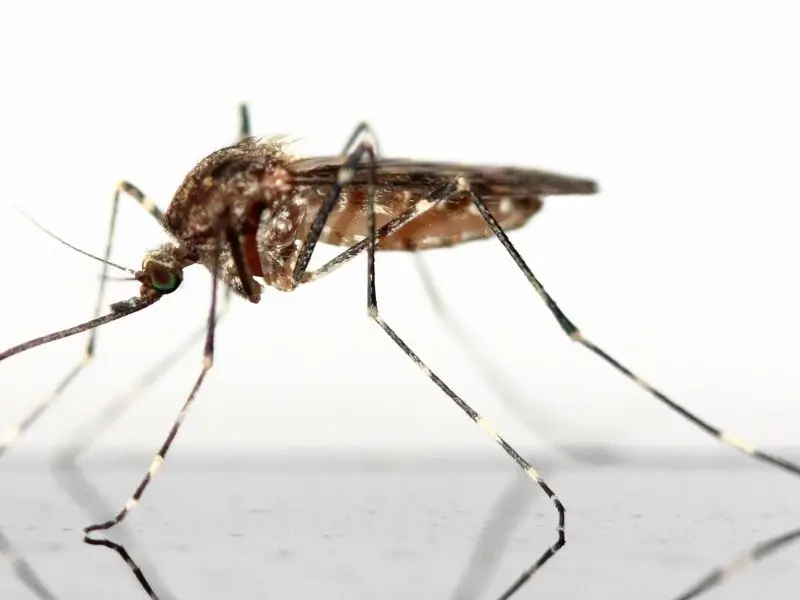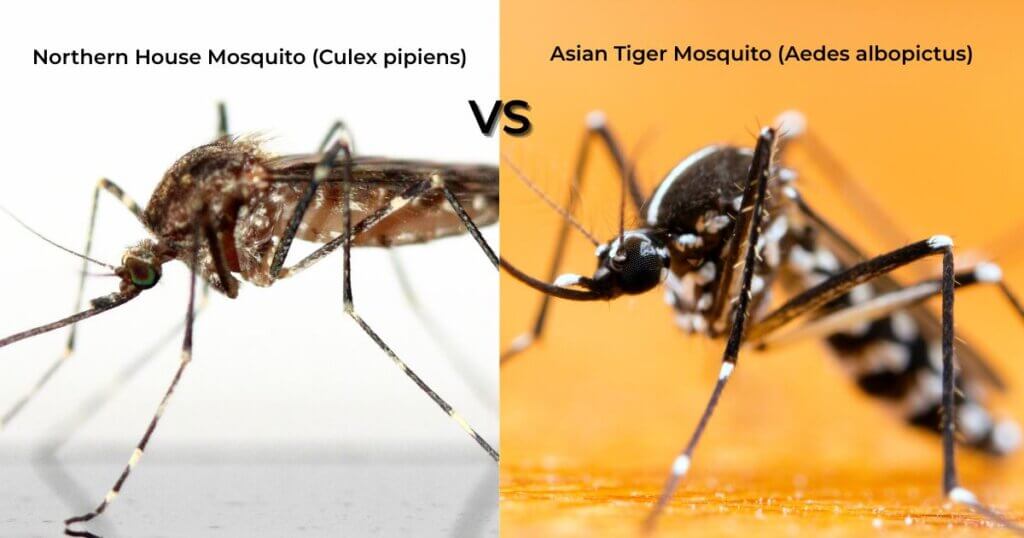
Northern House Mosquito (Culex pipiens) Identification
What is the Northern House Mosquito?
Scientific Name: Culex pipiens
Also Known As: Common House Mosquito
Quick Facts Table:
| Characteristic | Details |
| Size | 4–10 mm |
| Color | Light brown with pale stripes |
| Lifespan | ~7–14 days (longer in cooler temps) |
| Active Months | Spring through Fall |
| Preferred Habitat | Standing water, drains, gutters |
Identification Guide
The Northern House Mosquito (Culex pipiens) is one of the most common—and troublesome— mosquito species in North Carolina. You may not think twice when you see one of these familiar critters flying around, but don’t let its appearance fool you: This mosquito can still pose serious health risks to humans and pets.
Knowing how to identify and control this species is one of the best ways to keep annoying bites and potential illnesses away.
Key Physical Features
The Northern House Mosquito is relatively small and unassuming, but there are a few features that help set it apart from other mosquito species:

- Light brown or tan body
- Pale bands on its legs
- Clear wings free of dark spots (which differentiate it from some other species like Anopheles mosquitoes, which have speckled wings).
- Long, slender proboscis—a needle-like mouthpart used by the female mosquito to pierce skin and feed on blood.
While they don’t have the stark black-and-white coloration of Aedes mosquitoes, their uniform appearance and tendency to bite at night are useful clues for identification. Their small size and tendency to fly low to the ground make them hard to spot, often going unnoticed until itchy bites appear the next day.
Behavioral Traits
The Northern House Mosquito has specific behavioral traits that make it both a persistent nuisance and a health risk. One of the most important things to understand is that only the female mosquitoes bite. They require a blood meal to develop their eggs, while males feed exclusively on plant nectar. Females are particularly active at dusk and throughout the night, which is when most bites occur.
These mosquitoes are also expert survivors. They prefer to rest in dark, humid areas during the day—common hiding spots include crawl spaces, under decks, in sheds, basements, and inside vegetation near homes. Their ability to find shelter in small, shaded areas makes them hard to spot until their population begins to boom.

They lay their eggs in standing or stagnant water, often in surprisingly small amounts. Any container or feature that collects water and remains undisturbed can become a breeding ground. Because they stay close to their hatching site, a single water source can lead to a major mosquito problem right in your backyard.
Lifecycle & Breeding Habits
The lifecycle of the Northern House Mosquito is quick, which means populations can grow very quickly during warm months. Their development includes four distinct life stages: egg, larva, pupa, and adult.
Four Life Stages:
- Eggs are laid in floating clusters known as rafts, often containing 100–300 eggs. These are deposited on the surface of still water.
- Larvae, also called "wrigglers," hatch within a day or two and feed on organic debris and microorganisms in the water. They come to the surface to breathe through siphon tubes.
- After several molts, they become pupae, a non-feeding stage where the mosquito transitions to adulthood. Pupae remain mobile and respond to light or movement.
- Finally, adult mosquitoes emerge from the pupal casing, ready to begin the cycle all over again.
In optimal conditions—warm weather and plenty of stagnant water—this process can take as little as 10–14 days.
Common Breeding Grounds:
These mosquitoes aren’t picky when it comes to egg-laying sites. They’re commonly found in:
- Birdbaths that aren’t cleaned regularly
- Rain barrels without proper screens or covers
- Clogged gutters holding decaying organic matter and water
- Storm drains, flower pot trays, buckets, and even the bases of lawn ornaments
Almost any place where water collects and remains undisturbed for a week or more can become a mosquito hot spot.
Health Risks & Concerns
Although the Northern House Mosquito may seem harmless, it’s known to be a carrier of some serious health risks.
Disease
Most famously, the Northern House Mosquito can be a primary transmitter of West Nile Virus. This disease caused by mosquitos can lead to flu-like symptoms, neurological complications, or even death—particularly in older adults or those with weakened immune systems. It’s also capable of spreading St. Louis Encephalitis, another viral disease that affects the nervous system.
Painful, Itchy Bites
For those not infected with a virus, mosquito bites can still cause itchy welts, allergic reactions, and secondary infections if scratched excessively. Children and individuals with sensitive skin may experience swelling, redness, and discomfort for several days after being bitten.
Danger to Pets
Pets are also vulnerable. Dogs and birds can suffer from mosquito-borne diseases, with some illnesses leading to severe or long-term health complications. While Culex mosquitoes are not the primary vectors for Zika or Dengue fever (those are typically spread by Aedes mosquitoes), their role in transmitting other serious viruses makes them a threat worth controlling.
Prevention Tips from A-1 Pest Control
Preventing a mosquito infestation starts with reducing their breeding grounds and making your home less attractive to them. At A-1 Pest Control, we recommend a few simple steps to get you started:
- Eliminate standing water wherever possible. This includes emptying containers like flower pots, buckets, and pet dishes after rainfall.
- Clean out gutters and drains regularly to prevent water buildup and leaf accumulation.
- Repair damaged window and door screens to keep mosquitoes from entering your home.
- Use yellow outdoor “bug lights” that are less attractive to flying insects and install fans on porches and patios—mosquitoes are weak fliers and avoid breezy areas.
- For ponds, birdbaths, and decorative water features, apply pet-safe larvicides to kill mosquito larvae before they can mature.
By addressing these simple maintenance tasks, you can drastically reduce mosquito activity around your property.
A-1’s Mosquito Control Services
Even with diligent prevention, mosquito populations can still become unmanageable—especially during peak mosquito season in North Carolina. That’s where A-1 Pest Control comes in. Our professional mosquito control services are designed to eliminate mosquitoes at all stages of their lifecycle using a combination of safe, effective treatment methods.
Our approach includes:
- Targeted yard treatments, including fogging, larvicide applications, and long-lasting barrier sprays
- Customized seasonal service plans based on local mosquito activity and weather patterns
- In-depth inspections to uncover hidden breeding zones around your property
- Eco-conscious and pet-friendly treatment options for families who prioritize environmental safety
We’ve been protecting North Carolina homes since 1966, and we bring decades of experience to every service visit.
Why A-1 Pest Control?
When you choose A-1 Pest Control, you’re working with a team of licensed professionals who are dedicated to your safety and comfort. Our mosquito control specialists are highly trained, fully certified, and committed to using the most advanced products and techniques available today.
Licensed and Certified Pros
Our mosquito control specialists are more than just technicians; they’re licensed professionals who undergo continuous training to stay ahead of industry standards and environmental regulations. With deep knowledge of local mosquito species and their breeding habitats, we tailor each treatment to effectively target problem areas specific to your property and region.
Safety First
We understand that safety is your top priority — and it’s ours, too. That’s why we offer treatments that are safe for families, children, and pets, with eco-conscious options available for those who prefer green solutions. Our approach combines cutting-edge products with proven techniques to deliver powerful results while minimizing environmental impact.
Fast, Reliable Service
At A-1 Pest Control, we value your time and comfort. Our team provides prompt, reliable service, and we offer flexible scheduling to meet the needs of busy homeowners. Every service is backed by our satisfaction guarantee, giving you peace of mind that your mosquito issues will be handled thoroughly and professionally.
But don’t just take our word for it — our commitment to excellence is reflected in hundreds of 5-star reviews from satisfied homeowners across North Carolina. They trust us not only for our results, but for our honesty, integrity, and unmatched customer care.
Frequently Asked Questions (FAQs)
Are Northern House Mosquitoes dangerous?
Yes, Northern House Mosquitos can be dangerous. While their bites are annoying, the real concern is their ability to spread diseases like West Nile Virus and St. Louis Encephalitis, especially to the elderly or immunocompromised.
How fast do they reproduce?
Under ideal conditions—warm weather and access to stagnant water—Culex mosquitoes can complete their lifecycle in as little as 10–14 days.
When are they most active?
These mosquitoes are most active during dusk and nighttime, unlike Aedes mosquitoes that bite during the day.
How are they different from Aedes mosquitoes?
Aedes mosquitoes have bold black-and-white markings and bite during daylight hours. Culex mosquitoes are more dull in color, and are mostly active after sunset.

